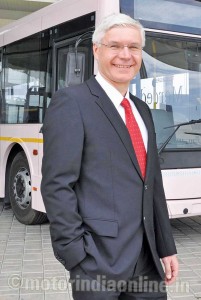By Dr. Wilfried G. Aulbur, Managing Partner, Roland Berger Strategy Consultants Pvt. Ltd., Mumbai
The new government in India has put infrastructure firmly in its focus. This has two immediate benefits: Short-term, we will see a boost from rising capex and construction work, and long-term, bottlenecks that cap growth in all other areas of the economy are eased.

The current focus on untangling the policy paralysis and trying to rev up the growth engine (e.g., via extending excise duty cuts on automobiles and capital goods, on-line environmental clearances for projects, fast clearances for about 280 big projects worth $300 billion, etc.) will put additional momentum into the economy. A GDP growth for FY 15 of 5+% and close to 7% in the next fiscal seems therefore attainable.
Over the last four quarters, shoots of an economic renewal were visible. Business confidence indices improved consistently, and some reached their highest level since four-five years in the last quarter. The main drivers were confidence in the macro-economic revival and the corresponding positive impact on sales and new orders.
As a result, the future of the Indian commercial vehicle industry is positive. Double-digit growth rates on the basis of the low FY14 volume are likely and would bring the overall industry volume to a very respectable 1.4 million units in 2020. In particular, SCVs and M/HCVs are segments that will show 13 per cent and 10 per cent CAGR going forward, and SCVs will continue to be the dominant segment with more than 60 per cent of industry volume.
The first quarter of the current financial year has shown signs of revival. The MHCV segment grew by 2.5 per cent for the first time in 13 quarters even though the overall CV industry still declined by 10 per cent over the last year. This is a good sign for the industry as the MHCV segment typically enjoys a very high correlation with the overall economic growth and is an early indicator for a macro-economic turnaround.
However, it may be a little early to conclude that all is well that ends well. The commercial vehicle industry has been impacted the most over the last two years of economic downturn declining ~11% between FY12 and FY14. Within the CV industry MHCV goods & LCV goods carrier segments have been impacted massively, declining at 26 per cent and 24 per cent respectively.
While truck rentals have been relatively flat, input costs have risen sharply. Diesel prices have gone up by almost 20 per cent from April’12 to July’14 and toll charges have also been on the rise, further increasing operating costs for truck owners. High interest rates of around 13-14 per cent for new and 15-17 per cent for used commercial vehicles have put additional stress on operators with small fleet owners being affected the most. Truck operators have in turn delayed purchases, and trucks are being used increasingly for longer periods. Extended lifetimes of CVs may be a permanent feature in the Indian CV market.
CV OEMs have been struggling over the last few years with both top and bottom line pressures. Their production costs have been rising however, due to a sluggish market. OEMs have not been able to pass on the cost burden to the customer. Faced with reduced volumes and low capacity utilizations (around 35-40 per cent on average), OEMs have resorted to increasing discounts (15-20 per cent) to stimulate the market and drive volumes. This, in turn, further led to a drop in used truck prices of 10-20 per cent further exacerbating the poor financial position of truck operators.
In this environment, and especially with the current low capacity utilizations, increasing volumes may not immediately translate into improved margins as competition for market share remains fierce and customers have gotten used to significant discounts.
Opportunities arise, however, not only from cost optimization but also from leveraging significant shifts in customer preferences. A case in point is the SCV segment. While this segment has historically been dominated by less than 2 ton vehicles, over the last year customers have shown an increasing tendency to shift to higher tonnage vehicles, in particular, 2.5 T pick up trucks. Early identification of these shifts or active management of the same via an aggressive price-value proposition for customers is a very effective way of maximizing sales and contribution.
After-sales is another area of opportunity since the average vehicle life is increasing and with it the need for maintenance. Many OEMs have realized this and are focusing on increasing network reach and sprucing up the quality of service. New entrants have leveraged relatively dense after-sales networks combined with good performance on key KPIs such as VOR to establish themselves in the competitive Indian environment both from a volume and brand reputation perspective.
In summary, India will be a leading commercial vehicle market by 2020 that will continue on its impressive growth trajectory. Short-term signs of revival show the way and are supported by decisive government action. However, while volumes will grow, margins will remain under pressure for the next one-two years. Winning OEMs will continue to focus on cost, aggressive leverage of emerging/growing customer segments as well as consistent delivery of a comprehensive value proposition, including aftersales.